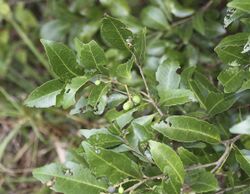Biology:Elaeocarpus obovatus
| Hard quandong | |
|---|---|

| |
| Elaeocarpus obovatus growing at Watagans National Park, Australia | |
| Scientific classification | |
| Kingdom: | Plantae |
| Clade: | Tracheophytes |
| Clade: | Angiosperms |
| Clade: | Eudicots |
| Clade: | Rosids |
| Order: | Oxalidales |
| Family: | Elaeocarpaceae |
| Genus: | Elaeocarpus |
| Species: | E. obovatus
|
| Binomial name | |
| Elaeocarpus obovatus G.Don[1]
| |
| Synonyms[1] | |
|
List
| |

Elaeocarpus obovatus, commonly known as hard quandong, blueberry ash, whitewood, grey carabeen, freckled oliveberry or gray carrobeen,[2] is a species of flowering plant in the family Elaeocarpaceae and is endemic to eastern Australia. It is a tree with buttress roots at the base of the trunk, egg-shaped to lance-shaped leaves with the narrower end towards the base, racemes of white flowers, and blue, oval fruit.
Description
Elaeocarpus obovatus is sometimes a small tree 3–10 m (9.8–32.8 ft) tall, and sometimes a tall tree growing to a height of 45 m (148 ft) with buttress roots at the base of a trunk that is up to 150 cm (59 in) in diameter. The outer bark is smooth, grey and thin with corky irregularities. The leaves are arranged alternately, egg-shaped to lance-shaped with the narrower end towards the base, 40–85 mm (1.6–3.3 in) long and 14–22 mm (0.55–0.87 in) wide on a petiole 2–6 mm (0.079–0.236 in) long. The edges of the leaves are wavy, scalloped or toothed and the midrib is raised on the upper and lower surfaces. The flowers are arranged in racemes of ten to twenty 40–80 mm (1.6–3.1 in) long, each on a pedicel 4–5 mm (0.16–0.20 in) long with four or five egg-shaped to triangular sepals 2–3 mm (0.079–0.118 in) long and 1–1.5 mm (0.039–0.059 in) wide. The petals are white, egg-shaped to oblong and about the same size as the sepals with the tip divided into eight to ten lobes and there are about twenty very short stamens. Flowering occurs from late August to October and the fruit is a oval to elliptical blue drupe about 10 mm (0.39 in) long and 8 mm (0.31 in) wide, containing a single seed. Fruiting occurs in January to April.[2][3][4][5]
Taxonomy
Elaeocarpus obovatus was first formally described in 1831 by George Don in his book A General History of Dichlamydeous Plants.[6][7]
Distribution and habitat
Hard quandong is a tall tree in subtropical rainforest and a small to medium-sized tree in drier rainforest and occurs from Proserpine, Queensland (20° S) in to central-eastern Queensland south as far as Wyong (33° S) in New South Wales.[2][5]
References
- ↑ 1.0 1.1 "Elaeocarpus obovatus". Australian Plant Census. https://biodiversity.org.au/nsl/services/apc-format/display/1159466.
- ↑ 2.0 2.1 2.2 "Elaeocarpus obovatus". Royal Botanic Garden, Sydney. https://plantnet.rbgsyd.nsw.gov.au/cgi-bin/NSWfl.pl?page=nswfl&lvl=sp&name=Elaeocarpus~obovatus.
- ↑ Hyland, Bernard; Coode, Mark J. (1984). "Elaeocarpus in Australia and New Zealand.". Kew Bulletin 39 (3): 533–538.
- ↑ "Elaeocarpus obovatus". Centre for Australian National Biodiversity Research (CANBR), Australian Government. 2020. https://apps.lucidcentral.org/rainforest/text/entities/Elaeocarpus_obovatus.htm.
- ↑ 5.0 5.1 Floyd, Alexander G. (1989). Rainforest trees of mainland South-eastern Australia. Melbourne: Inkata Press. p. 116. ISBN 0909605572.
- ↑ "Elaeocarpus obovatus". APNI. https://id.biodiversity.org.au/instance/apni/550773. Retrieved 21 February 2021.
- ↑ Don, George (1831). A General History of Dichlamydeous Plants. London: J.G. and F. Rivington,1831-1838. p. 559. https://www.biodiversitylibrary.org/item/9904#page/587/mode/1up. Retrieved 21 February 2021.
Wikidata ☰ Q5353092 entry
 |

